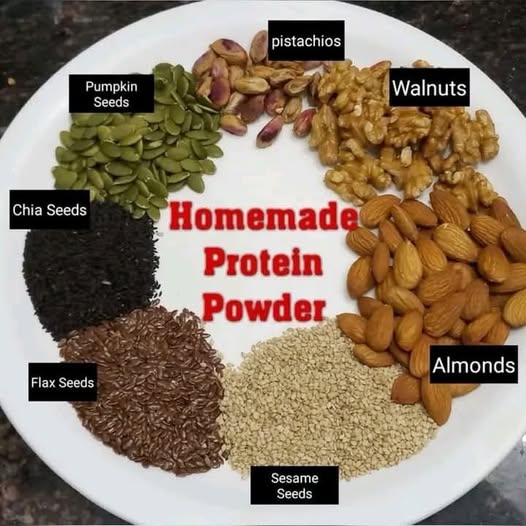Introduction
In today’s fast-paced world, protein powder has become a popular supplement for athletes, fitness enthusiasts, and those seeking to maintain a healthy lifestyle. However, many commercial protein powders contain artificial additives, sweeteners, and other undesirable ingredients. That’s why making your own homemade protein powder is a great way to ensure you’re consuming a pure, natural, and nutritious product.
Benefits of Homemade Protein Powder
- Control Over Ingredients: You can customize your protein powder to your specific dietary needs and preferences.
- Natural and Organic: Avoid artificial additives, preservatives, and sweeteners found in many commercial protein powders.
- Nutrient-Rich: Homemade protein powder can be packed with essential vitamins, minerals, and antioxidants.
- Cost-Effective: Making your own protein powder can save you money in the long run.
- Delicious Flavor: You can experiment with different flavors and combinations to create a tasty and satisfying protein powder.
Recipe for Homemade Protein Powder
Ingredients:
- 25g Pistachios
- 25g Walnuts
- 25g Pumpkin Seeds
- 25g Chia Seeds
- 25g Flaxseeds
- 25g Sesame Seeds
- 25g Almonds
Instructions:
-
Prep the Ingredients:
- Toast the nuts and seeds in a dry skillet over medium heat for a few minutes, or until fragrant. This helps to enhance their flavor and nutritional value.
- Let the nuts and seeds cool completely before proceeding.
-
Grind the Ingredients:
- Add the toasted nuts and seeds to a high-powered blender.
- Blend on high speed until a fine powder is formed. This may take a few minutes, depending on the power of your blender.
- If your blender struggles to grind the nuts and seeds into a fine powder, you can grind them in batches or use a coffee grinder.
-
Store the Protein Powder:
- Transfer the homemade protein powder to an airtight container.
- Store in a cool, dry place away from direct sunlight.
How to Use Homemade Protein Powder
You can use your homemade protein powder in various ways:
- Smoothies: Blend the powder with fruits, yogurt, milk, or plant-based milk for a nutritious and delicious smoothie.
- Protein Shakes: Mix the powder with water, milk, or plant-based milk for a quick and easy protein shake.
- Baking: Incorporate the powder into baked goods like pancakes, muffins, and cookies.
- Toppings: Sprinkle the powder on yogurt, oatmeal, or cereal for an extra protein boost.
Additional Tips for Making Homemade Protein Powder
- Experiment with Flavors: Add cocoa powder, vanilla extract, or other natural flavorings to your protein powder.
- Customize Your Blend: Adjust the quantities of each ingredient to suit your specific dietary needs and preferences.
- Consider Adding Other Ingredients: You can add other nutrient-rich ingredients like hemp seeds, cocoa nibs, or maca powder.
- Store in an Airtight Container: This will help to keep your protein powder fresh and prevent it from going rancid.
By making your own protein powder, you can take control of your nutrition and enjoy a delicious and healthy supplement.
Beyond the Basic Recipe: Exploring Other Options
While the recipe above provides a solid foundation, there are many other ways to customize your homemade protein powder. Here are a few ideas:
Plant-Based Protein Powders:
- Pea Protein Powder: A complete protein source that is easy to digest and hypoallergenic.
- Soy Protein Powder: A popular choice with a complete amino acid profile.
- Rice Protein Powder: A hypoallergenic option that is gentle on the digestive system.
- Hemp Protein Powder: A complete protein source with essential fatty acids.
Nut and Seed-Based Protein Powders:
- Almond Protein Powder: A versatile protein powder with a mild flavor.
- Cashew Protein Powder: A creamy and slightly sweet protein powder.
- Sunflower Seed Protein Powder: A hypoallergenic option with a nutty flavor.
Additional Ingredients to Consider:
- Superfoods: Add ingredients like spirulina, chlorella, or maca powder for extra nutritional benefits.
- Probiotics: Incorporate probiotic powders to support gut health.
- Prebiotics: Add prebiotic fibers like inulin or acacia fiber to feed the beneficial bacteria in your gut.
- Vitamins and Minerals: Consider adding a vitamin and mineral supplement to your protein powder.
Remember:
- Always consult with a healthcare professional before making significant changes to your diet, especially if you have underlying health conditions.
- Store your homemade protein powder in a cool, dry place to maintain its freshness.
- Experiment with different flavors and combinations to find your perfect protein powder blend.
By taking the time to make your own protein powder, you can enjoy a nutritious and delicious supplement that supports your health and fitness goals.
